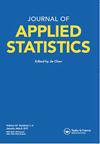COVID-19对金融市场影响的时变核密度和时间顺序估计
IF 1.2
4区 数学
Q2 STATISTICS & PROBABILITY
引用次数: 11
摘要
时变核密度估计依赖于两个自由参数:带宽和折现系数。我们建议选择这些参数,以便最小化符合概率密度预测验证传统要求的准则。这些要求是所谓的概率积分变换的均匀性和独立性,即应用于观测的预测时变累积分布。因此,我们建立了一个新的数值准则,结合了一致性和独立性的性质,通过一个适应的Kolmogorov-Smirnov统计量的平均值。我们将这一方法应用于2019冠状病毒病危机期间的金融市场。我们确定了几个股票指数的日价格回报的时变密度,并使用各种差异统计,我们能够描述危机的时间顺序以及区域差异。例如,我们观察到COVID-19对中国金融市场的影响较为有限,对美国的影响较大,对欧洲的复苏缓慢。本文章由计算机程序翻译,如有差异,请以英文原文为准。
Estimation of time-varying kernel densities and chronology of the impact of COVID-19 on financial markets
The time-varying kernel density estimation relies on two free parameters: the bandwidth and the discount factor. We propose to select these parameters so as to minimize a criterion consistent with the traditional requirements of the validation of a probability density forecast. These requirements are both the uniformity and the independence of the so-called probability integral transforms, which are the forecast time-varying cumulated distributions applied to the observations. We thus build a new numerical criterion incorporating both the uniformity and independence properties by the mean of an adapted Kolmogorov-Smirnov statistic. We apply this method to financial markets during the COVID-19 crisis. We determine the time-varying density of daily price returns of several stock indices and, using various divergence statistics, we are able to describe the chronology of the crisis as well as regional disparities. For instance, we observe a more limited impact of COVID-19 on financial markets in China, a strong impact in the US, and a slow recovery in Europe.
求助全文
通过发布文献求助,成功后即可免费获取论文全文。
去求助
来源期刊

Journal of Applied Statistics
数学-统计学与概率论
CiteScore
3.40
自引率
0.00%
发文量
126
审稿时长
6 months
期刊介绍:
Journal of Applied Statistics provides a forum for communication between both applied statisticians and users of applied statistical techniques across a wide range of disciplines. These areas include business, computing, economics, ecology, education, management, medicine, operational research and sociology, but papers from other areas are also considered. The editorial policy is to publish rigorous but clear and accessible papers on applied techniques. Purely theoretical papers are avoided but those on theoretical developments which clearly demonstrate significant applied potential are welcomed. Each paper is submitted to at least two independent referees.
 求助内容:
求助内容: 应助结果提醒方式:
应助结果提醒方式:


